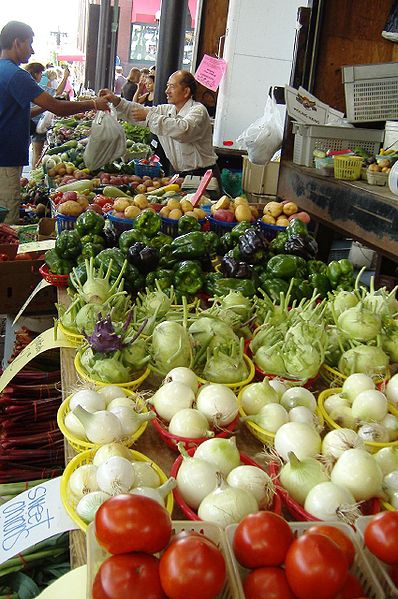Last updated on January 16, 2016
(January 16, 2016 Update: If you came here from the New York Times website, thank you for your visit, and please note that the findings discussed below have changed slightly due to our incorporating two more years of data since this was posted last summer. Our new findings will be presented and discussed in an updated version of the working paper discussed in this post, which I am hoping to release before the end of March 2016. In the meantime, some of those new findings are discussed in the New York Times article.)

When I arrived at the University of Minnesota in the fall of 2013, a few colleagues and I applied for a seed grant from the university’s Healthy Foods, Healthy Lives Institute by submitting a proposal to look at the impact of local and organic foods and food safety.
After working on it for almost two years, I am happy to finally be able to circulate my new paper titled “Farmers Markets and Food-Borne Illness,” coauthored with my colleague Rob King and my student Jenny Nguyen, in which we ask whether farmers markets are associated with food-borne illness in a systematic way. In order to answer that question, we use a US state-level panel data set for the years 2004, 2006, and 2008-2011 (i.e., the years for which we had a full data set).
Here is the abstract:
We study the relationship between farmers markets and food-borne illness in the United States. Using a state-level panel data set for the period 2004-2011, we find a positive relationship between the number of farmers markets per capita on the one hand and, on the other hand, the number of reported (i) outbreaks of food-borne illness, (ii) cases of food-borne illness, (iii) outbreaks of Campylobacter jejuni, and (iv) cases of Campylobacter jejuni. Our estimates indicate that a 1% increase in the number of farmers markets is associated with a 0.7% (3.9%) increase in the total number of reported outbreaks of food-borne illness (Campylobacter jejuni), and a 3.9% (2.1%) increase in the total number of reported cases of food-borne illness (Campylobacter jejuni) in the average state-year. Our estimates also suggest that a doubling of the number of farmers markets in the average state-year would be associated with an economic cost of over $900,000 in additional cases of food-borne illness. When controlling simultaneously for both the number of farmers markets and the number of farmers markets that accept SNAP benefits (i.e., food stamps), we find that they are respectively associated positively and negatively with reported food-borne illness outbreaks and cases. Our results are robust to different specifications and estimators, and falsification and placebo tests indicate that they are unlikely to be spurious.
In sum, what we find is:
- A positive relationship between the number of farmers markets and the number of reported outbreaks of food-borne illness in the average state-year.
- A positive relationship between the number of farmers markets and the number of reported cases of food-borne illness in the average state-year.
- A positive relationship between the number of farmers markets and the number of reported outbreaks of Campylobacter jejuni in the average state-year.
- A positive relationship between the number of farmers markets and the number of reported cases of Campylobacter jejuni in the average state-year.
- Six dogs that didn’t bark, i.e., no systematic relationship between the number of farmers markets and the number of outbreaks or cases of norovirus, Salmonella enterica, Clostridium perfringens, E. coli, Staphylococcus (i.e., staph), or scombroid food poisoning.
- When controlling for the number of farmers markets, there is a negative relationship between the number of farmers markets that accept SNAP and food-borne illness in the average state-year.
- A doubling of the number of farmers markets in the average state-year would be associated with a relatively modest economic cost of about $900,000 in terms of additional cases of food-borne illness.
Of course, correlation is not causation, which is why we spend a great deal of time in the paper discussing the potential threats to causal identification in this context, investigating them, and trying to triangulate our findings with a number of different specifications and estimators. At the end of the day, we are pretty confident in the robustness of our core finding, viz. that there is a positive association between the number of farmers markets and the number of reported outbreaks and cases of food-borne illness.
Lastly, some may ask whether it would have been possible to look at a more micro level than the state level. The short answer is no, because the CDC data we use report outbreaks at the state level only, they do not report the point of purchase of various foods–only the location of consumption (e.g., home, school, church, restaurant), and then again, only in some cases. Likewise with the food vehicle behind an outbreak.